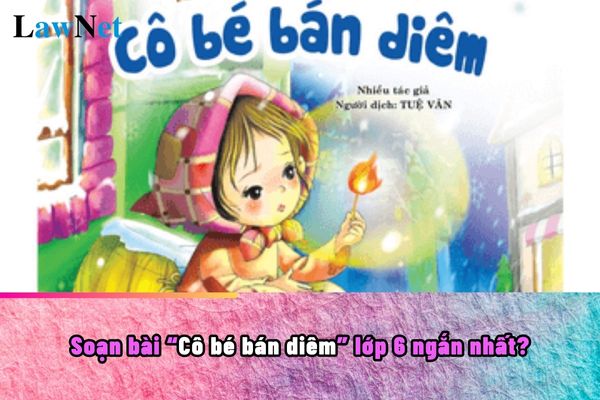What are guidelines on preparing the lesson "The Little Match Girl" for grade 6 students in Vietnam? What are rights of grade 6 students in Vietnam?
What are guidelines on preparing the lesson "The Little Match Girl" for grade 6 students in Vietnam?
"The Little Match Girl" is one of the lessons that students will study in the latest grade 6 Literature curriculum.
Teachers, parents, and students can refer to the following guidelines on preparing the lesson "The Little Match Girl" for grade 6 students:
|
Guidelines on preparing the lesson "The Little Match Girl" for grade 6 students * Main content of the lesson: |
*Note: The information on the shortest guide to preparing the lesson "The Little Match Girl" for Grade 6 is for reference only./.

What are guidelines on preparing the lesson "The Little Match Girl" for grade 6 students in Vietnam? What are rights of grade 6 students in Vietnam? (Image from the Internet)
What are rights of grade 6 students in Vietnam?
Based on Clause 2, Article 35 of the Charter of Lower Secondary Schools, Upper Secondary Schools, and Schools with Multiple Education Levels issued with Circular 32/2020/TT-BGDDT:
Rights of Students
1. To be equal in accessing comprehensive education, to have ensured conditions in terms of time, facilities, hygiene, safety for studying in class, and self-study at home; to be provided with information on one's learning and training, to use equipment and means serving educational, cultural, and physical activities of the school according to regulations.
2. To be respected and protected, to be treated equally and democratically, to have the right to file complaints with the school and educational management levels regarding decisions concerning themselves; to transfer schools for legitimate reasons according to current regulations; to study ahead of schedule, skip grades, or study older than the prescribed age according to Article 33 of this Charter.
3. To participate in activities aimed at developing talents in subjects, sports, and arts organized by the school if eligible.
4. To receive scholarships or other allowances according to policy for socially supported students, students with difficult living conditions, and students with special abilities.
5. To transfer schools if meeting the conditions as prescribed; transfer procedures are implemented according to the regulations of the Ministry of Education and Training.
6. To enjoy other rights as prescribed by law.
Concurrently, the duties of Grade 6 students are stipulated in Article 34 of the Charter of Lower Secondary Schools, Upper Secondary Schools, and Schools with Multiple Education Levels issued with Circular 32/2020/TT-BGDDT:
- Perform learning and training tasks according to the school's educational program and plan.
- Respect parents, staff, teachers, school employees, and elders; unite and assist each other in learning and training; comply with the school’s rules and regulations; abide by the laws of the State.
- Train physically, maintain personal hygiene.
- Participate in collective activities of the school, class, Ho Chi Minh Young Pioneer Organization, and Ho Chi Minh Communist Youth Union; assist families, participate in labor and social activities, environmental protection activities, traffic safety implementation.
- Preserve and protect the school's assets, public places; contribute to building, protecting, and promoting the school's tradition.
Is academic dishonesty by grade 6 students in Vietnam considered a prohibited act?
The prohibited acts for Grade 6 students are stipulated in Article 37 of the Charter of Lower Secondary Schools, Upper Secondary Schools, and Schools with Multiple Education Levels issued with Circular 32/2020/TT-BGDDT:
(1) Insulting the dignity, honor, infringing upon the physical body of teachers, staff, other school personnel, others, and other students.
(2) Academic dishonesty in study, exams, assessments, and admissions.
(3) Buying, selling, consuming alcohol, beer, tobacco, addictive substances, other stimulants, fireworks, and explosive materials.
(4) Using mobile phones, other devices that do not serve learning purposes and without teacher permission during class.
(5) Fighting, disrupting order, and security within and outside the school.
(6) Using or exchanging cultural products with content inciting violence, obscenity; using toys or playing games harmful to one's healthy development.
(7) Students are prohibited from violating other prohibited acts as prescribed by law.
Thus, academic dishonesty is one of the prohibited acts for Grade 6 students.

